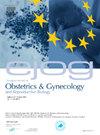Should men whose female partners have cervical high grade intraepithelial lesion (HSIL) be screened?
IF 2.1
4区 医学
Q2 OBSTETRICS & GYNECOLOGY
European journal of obstetrics, gynecology, and reproductive biology
Pub Date : 2025-03-08
DOI:10.1016/j.ejogrb.2025.03.001
引用次数: 0
Abstract
Objective
The subject of screening for genital HPV lesions in the male partner of women with cervical high-grade squamous intraepithelial lesions (HSIL) remains a topic of discussion. The present study evaluated the prevalence of penile high-grade squamous intraepithelial lesion (HSIL) clinical lesions in 196 men whose female partners had been diagnosed with cervical low-grade and high-grade intraepithelial lesions (LSIL, HSIL) in Ile-de-France.
Methods
In cases involving couples where the female partner had been diagnosed with a cervical LSIL or HSIL lesion, the male partner underwent examination using the peniscopy method. The presence of clinical identified HPV lesions was confirmed by biopsy proven histological analysis.
Results
The mean age of the 196 couples was 33.4 years for women and 35.6 years for men. Among the 196 women, 125 (64 %) had cervical LSIL and 71 (36 %) had cervical HSIL detected by colposcopy and confirmed by histology. Among 196 men, 65 (33 %) HPV lesions were identified and confirmed by histology. Of these, 44/196 (22 %) were penile LSIL and 21/196 (11 %) were penile HSIL. The risk of penile HSIL increased twofold (Fisher test 1.9) if the female partner had cervical HSIL (11/71, 15.5 %) versus cervical LSIL (10/125, 8 %).
Conclusion
A man with a partner who has cervical HSIL is twice as likely to have penile HSIL than if his partner has LSIL cervical. This suggests that peniscopy should be offered to this population. It could avoid the persistence or recurrence of cervical HSIL of their partner.
女性伴侣患有宫颈高级别上皮内病变(HSIL)的男性是否应该进行筛查?
目的宫颈高级别鳞状上皮内病变(HSIL)女性男性伴侣生殖器HPV病变筛查的主题仍然是一个讨论的话题。本研究评估了法兰西岛196名女性伴侣被诊断为宫颈低级别和高级别上皮内病变(LSIL, HSIL)的男性的阴茎高级别鳞状上皮内病变(HSIL)临床病变的患病率。方法在女性被诊断为宫颈低级别鳞状上皮内病变或宫颈高级别鳞状上皮内病变的夫妻中,男性接受阴茎法检查。临床鉴定的HPV病变的存在被活检证实的组织学分析。结果196对夫妇的平均年龄女性为33.4岁,男性为35.6岁。196例女性中,125例(64%)宫颈低级别鳞状上皮性病变,71例(36%)宫颈低级别鳞状上皮性病变经阴道镜检查并经组织学证实。在196名男性中,65例(33%)HPV病变被发现并经组织学证实。其中,44/196例(22%)为阴茎低sil, 21/196例(11%)为阴茎HSIL。如果女性伴侣患有宫颈HSIL(11/ 71,15.5%)与宫颈HSIL(10/ 125,8%)相比,阴茎HSIL的风险增加了两倍(Fisher检验1.9)。结论男性伴宫颈HSIL者发生阴茎HSIL的可能性是伴宫颈HSIL者的两倍。这表明应该向这一人群提供阴茎。可避免伴侣宫颈HSIL的持续或复发。
本文章由计算机程序翻译,如有差异,请以英文原文为准。
求助全文
约1分钟内获得全文
求助全文
来源期刊
CiteScore
4.60
自引率
3.80%
发文量
898
审稿时长
8.3 weeks
期刊介绍:
The European Journal of Obstetrics & Gynecology and Reproductive Biology is the leading general clinical journal covering the continent. It publishes peer reviewed original research articles, as well as a wide range of news, book reviews, biographical, historical and educational articles and a lively correspondence section. Fields covered include obstetrics, prenatal diagnosis, maternal-fetal medicine, perinatology, general gynecology, gynecologic oncology, uro-gynecology, reproductive medicine, infertility, reproductive endocrinology, sexual medicine and reproductive ethics. The European Journal of Obstetrics & Gynecology and Reproductive Biology provides a forum for scientific and clinical professional communication in obstetrics and gynecology throughout Europe and the world.

 求助内容:
求助内容: 应助结果提醒方式:
应助结果提醒方式:


